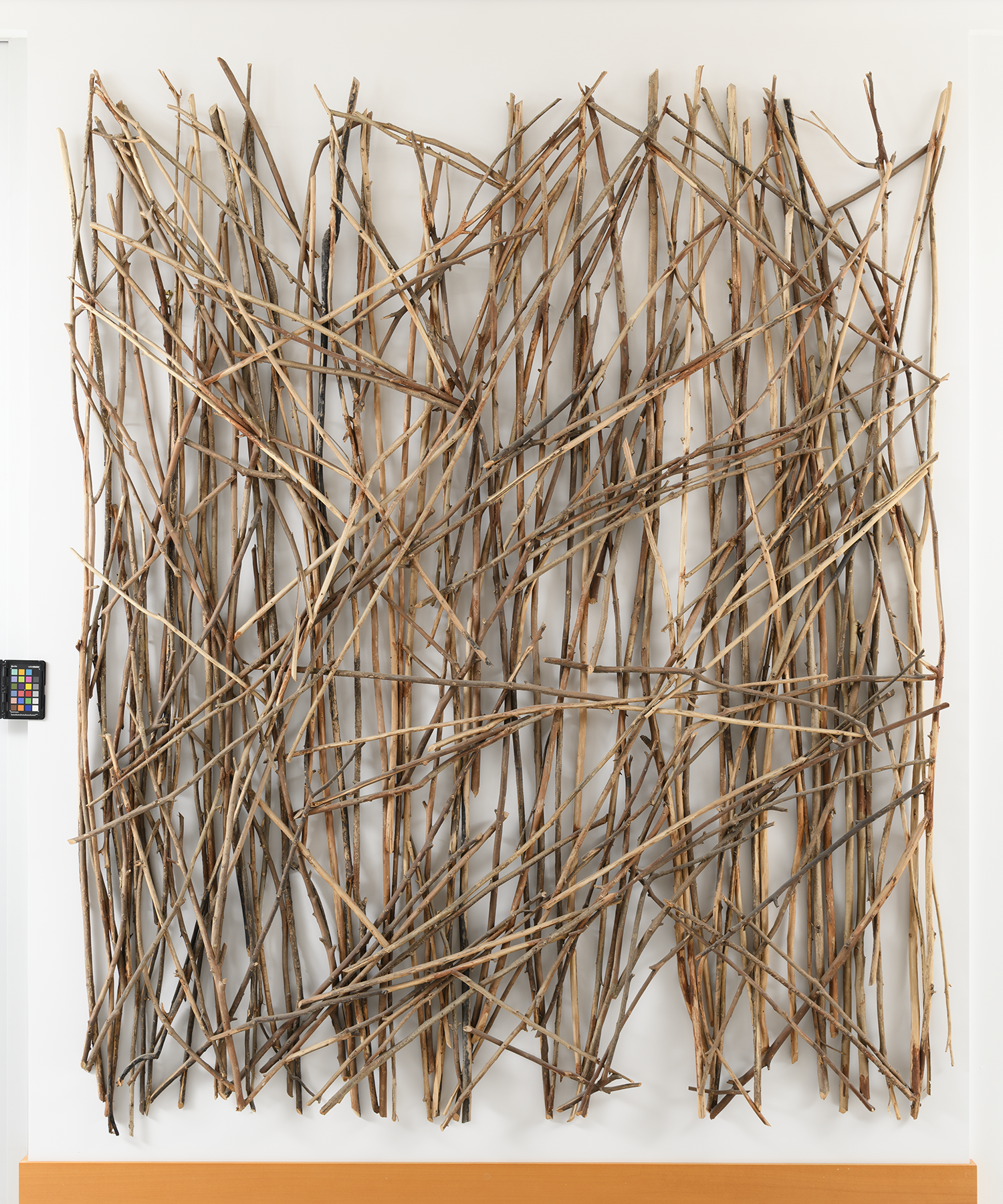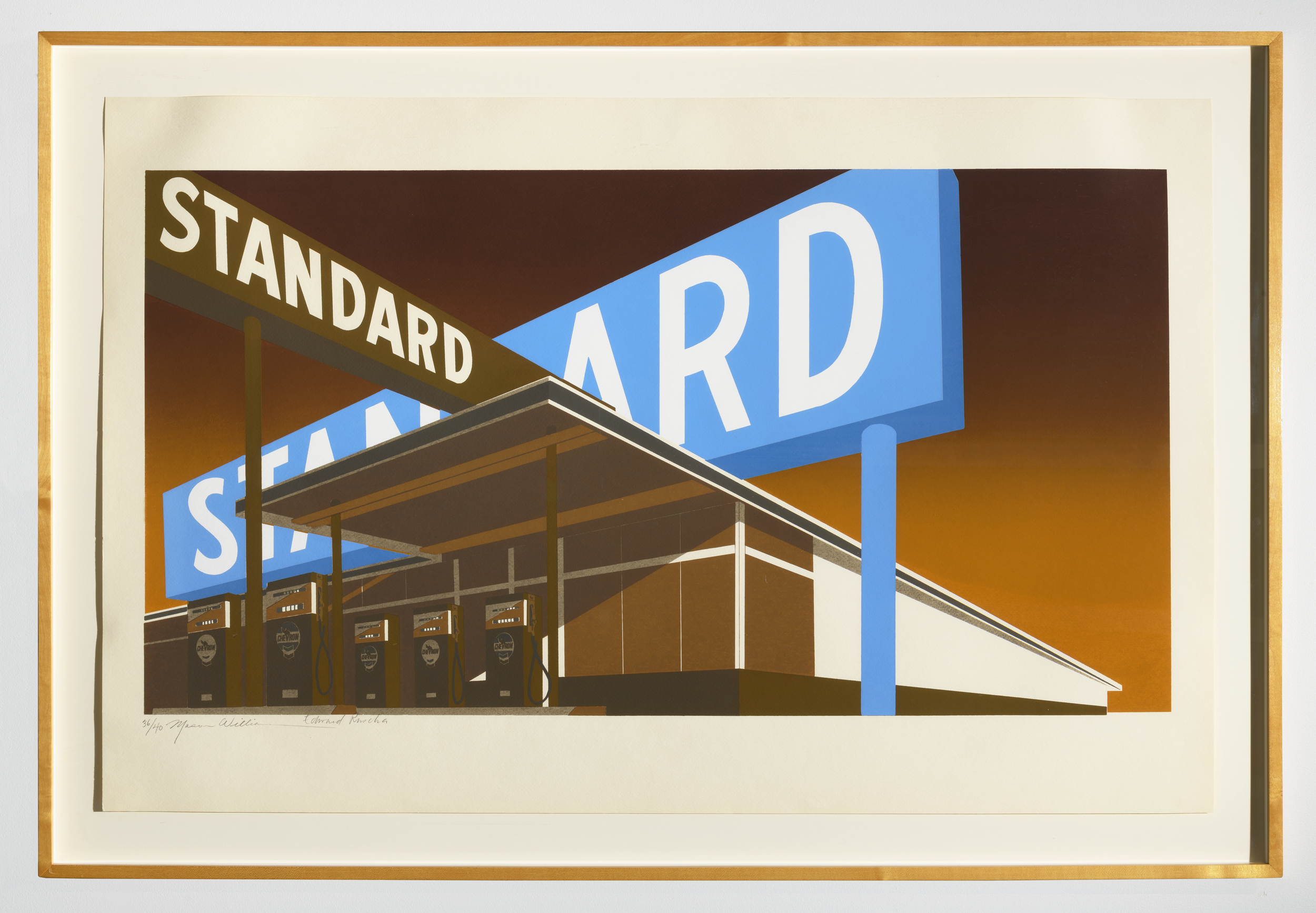
CHARLES ARNOLDI AND FRANK GEHRY
Frank Gehry and Charles Arnoldi in Arnoldi’s studio, Venice Beach, June 12, 2021
Rachel McCullah Wainwright, Curator of Collections and Exhibitions at the Bakersfield Museum of Art, speaks with artist Charles Arnoldi and architect Frank Gehry about friendships and the LA Art Scene of the 1970s. A selection of never-before-exhibited works by many of the artists discussed are currently on view as part of On the Edge: Los Angeles Art, 1970s—1990s from the Joan and Jack Quinn Collection at the Bakersfield Museum of Art.
Rachel McCullah Wainwright: Thank you so much for allowing me to interview you today. I’d love to start by asking each of you to set the tone and explain what the LA art scene looked like in the late 1960s and 1970s?
Charles Arnoldi: It was interesting, I got accepted into this group of artists after I won this Young Talent Award in 1969, which I wasn’t supposed to even apply for because I was a student at Chouinard and was kicked out after I won. But I was hanging around the art world because I was making and hustling frames. About that time, I moved down to Venice Beach and met Billy Al Bengston, John Altoon, Kenny Price, Larry Bell, Robert Irwin, and Frank Gehry, who was hanging out with these visual artists even though he was an architect. He was an integral part of the scene, which was interesting.
I think Frank found the artist lifestyle fascinating-artists would rent a shitty space as cheap as possible, put up some walls and half the time wouldn’t sheetrock both sides of the wall because they could only afford to do one side. I remember when Larry Bell did that; he loved the way the plumbing looked so he used a piece of glass instead of sheetrock. I think this resourcefulness was really inspiring for Frank. He said earlier he is assuming that’s what it was, especially in comparison to the rigidity of architects.
Bengston was like the head honcho. He knew how to dress, how to shop, how to cook. He knew about classical music. He read books. And he, like Peter Alexander, lived in a fancy house and could mix martinis. You would always see new and unique people at his home, and everyone became really tight-knit. Everyone knew everything and what everybody was doing all the time. And if you had an opening or a birthday, we all would get together.
At this point, there were two families that were involved in the L.A. art scene. One was the Grinsteins, and the other was the Quinns. Jack was this big lawyer and he basically said he would, if any of us got in trouble, take care of it, and you’d pay him with art. The Quinns were right in the middle of it all. If there was an opening, we’d usually have cocktails at their house before, or we’d go out to dinner and either Jack Quinn or Stanley Grinstein would pick up the tab. The artists weren’t allowed to spend any money.
Lynda Benglis and Charles Arnoldi, 1977. Photo courtesy of Joan Agajanian Quinn. ©Joan Quinn Archives. All Rights Reserved.
Charles Arnoldi, Billy Al Bengston, Robert Graham, and Joan Quinn, 1976. Photo courtesy of Joan Agajanian Quinn. ©Joan Quinn Archives. All Rights Reserved.
RMW: Frank, what are your memories from the period? When did you meet Chuck and the Quinns?
Frank Gehry: I saw that show when Chuck won the Young Artist Award: I remember seeing that plexi piece and I loved it. Then I met him, and he was personable. I knew he was part of the group, and I was interested in young talent because I was a young talent. I could tell he was barely making it because he was doing haircuts for all the artists who would pay him twenty dollars and that’s what he lived on. And so it was, I was attracted to the ingenuity I saw in Chuck and Laddie (John Dill).
CA: Well, when I moved to Venice so did a lot of other younger artists like Ron Cooper, Jim Ganzer, and Laddie John Dill.
FG: (John) McCracken too. About that time, I bought a McCracken from Irving Blum for $1,200. He tried to sell me one of Warhol’s Brillo Boxes instead, but the reason I wanted the McCracken was because it was so beautiful. And I guess at the beginning I was very into minimalism, because everybody was, that was it. You know, I was poor, so I wasn’t buying anything to make money on it. I just loved art at that point. And I loved Chuck’s piece and I thought this guy’s going to go to the moon.
RMW: And why did you surround yourself with these artists and not with other architects?
FG: I always say that Giotto, who’s known as a great painter, became an architect. El Greco became an architect. Michelangelo, sculptor/painter, became an architect. Bernini and Borromini were both artists and architects. So, in my mind architecture was always an art. While I was studying architecture at USC, I was going to all the art openings. I knew who everybody was. I knew Larry Bell. I knew Ed Moses by his work; I was attracted to his work before I met him. And I remember thinking Moses is going somewhere, and he did. But you really can’t predict all of that.
To me, architecture was art. The architecture students I graduated with and architecture scene in L.A. were Neutra and Schindler. And Schindler was doing stuff that was in the aesthetic realm of what Billy Al (Bengston) was doing in the studio.
Ken Price and Ed Moses, 1977. Photo courtesy of Joan Agajanian Quinn. ©Joan Quinn Archives. All Rights Reserved.
Laddie John Dill, Peter Alexander, and Elyse Grinstein, 1978. Photo courtesy of Joan Agajanian Quinn. ©Joan Quinn Archives. All Rights Reserved.
Charles Arnoldi, Joe Fay, Laddie John Dill, and Jack Quinn, 1978. Photo courtesy of Joan Agajanian Quinn. ©Joan Quinn Archives. All Rights Reserved.
Joan Quinn and Billy Al Bengston, 1979. Photo courtesy of Joan Agajanian Quinn. ©Joan Quinn Archives. All Rights Reserved.
RMW: And how about Joan and Jack?
FG: I met them through all the artists. It must have been about the time when I designed the exhibit for Billy Al’s show at the county museum. I knew that Billy Al had done motorcycling with the Agajanian family.
I had spent all those years at Billy’s studio, and every month he would change the decor. The biggest tragedy is that we didn’t photograph all his stuff. Talk about a decorator— I wouldn’t want him to be considered a decorator, but that’s where I learned a lot about my own aesthetic, by watching him change his studio all the time. And I must have met the Quinns at Billy’s. Billy was my initial connection to the Quinns.
CA: Billy would have an Academy Awards party every year. He had annual parties.
FG: And Billy loved movie stars.
CA: Everyone loved the movie stars, (Ed) Ruscha especially loved them, and there was a lot of flirting back and forth. Billy was a connector and operator, and it was astounding. His knowledge of fashion and culture. Larry Bell got to be a stylish guy because of Billy, you know. Billy knew all the stores on Rodeo Drive and everything. But the thing was that it was such a tight-knit group, and we were all young and we partied a lot and the Grinsteins and Quinns were part of the scene.
J.C. Agajanian had a house up in Beverly Hills with a tennis court and Joe Fay and I and some other artists started playing tennis every Sunday morning with Jack Quinn and guys like Matt Byrne and John Van de Kamp. Powerful guys, you know? And so, because of the Quinns, the art scene linked over to other worlds.
FG: Jack and Joan were part of it. It was a social scene. And Jack went in and defended the artists for no charge, except art.
CA: Yeah. If you had any questions, you could call Jack up. He had a huge law firm and if he couldn’t do it, he’d just assign someone else to help you.
FG: I was doing a project for the Rouse Company (1970s) in Maryland. And there was a lawsuit. It was the first time I ever experienced a lawsuit, and I was vulnerable. Jack helped me. He came across the country and guided me through the process, and ultimately got me out of it. I didn’t have money to pay him, so I gave him whatever I had, and it was a big bar-like table. At the time I was experimenting with furniture. How many curves could you get before it bounces.
CA: The firm and artists were constantly making trades and Ruscha once gave him a small piece that said, “There’s No Job Too Small.” And nobody wanted it hung near their office because it was implying the wrong thing. So, nobody wanted the Ruscha, which is laughable now!
But a lot of the attorneys would end up at the parties and come to our openings. You need suits, you need businesspeople that support art. They are the bridge between artists and the real world. It was a fun scene and anytime someone needed something someone was there to help, and Jack was our legal advisor.
FA: I remember sometimes when I got worried about something legal, Joan would overhear and tell me “Call Jack” and when you did, he was always there.
CA: The Quinns and the Grinsteins made the California scene really happen because they invited all the famous New York artists out here. We got to schmooze with Robert Rauschenberg, Jasper Johns, and Claus Oldenburg. All those guys came out and we’d hang out and party. I never thought of them as famous artists. They were just great guys. But if it weren’t for the people like the Quinns, Grinsteins, and Weismans, all this stuff wouldn’t have really happened. You know they really are central to the story.
Charles Arnoldi and Frank Gehry in Arnoldi’s studio, Venice Beach, June 12, 2021
Preview images from On the Edge: Los Angeles Art,1970s—1990s from the Joan and Jack Quinn Family Collection.

Charles Arnoldi, Untitled, Circa 1970, Wooden sticks, 90 x 70 inches. Photo by Alan Shaffer.

Ed Ruscha, Double Standard #36/40, 1969, Silkscreen, 30.25 x 44.75 inches. Photo by Alan Shaffer.

Billy Al Bengston, Koa Draculas, 1981, Acrylic on canvas, 28 x 28 inches. Photo by Alan Shaffer.

Ken Price, Snail Cup, 1971, Ink, acrylic and colored pencil on paper, 14.5 x 11.5 inches. Photo by Alan Shaffer.






